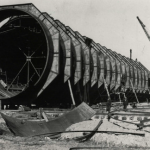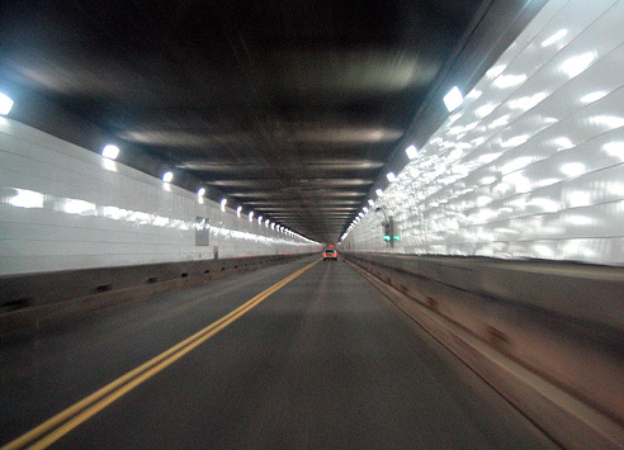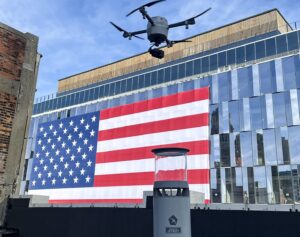Connecting Detroit, Michigan to Windsor, Ontario the Detroit-Windsor Tunnel is the only existing underwater international passenger car border crossing in the world. Approximately 10,000 vehicles pass through it daily, totaling nearly four million annually, of which 98% are cars and 2% are trucks and buses.
Built in 1930 and costing $23 million, it has been recognized as one of the great engineering wonders of the world. Detroitisit received a “behind the scenes” exclusive tour led by SVP of operations and engineering Trevor Pearce from the Detroit Windsor Tunnel LLC. and Chris Tremblay General Manager of Windsor Detroit Border Link.
The History
Construction of the tunnel took 26 months, and it first opened to traffic on November 3, 1930. However, the idea for the U.S.-Canada tunnel arose over 150 years ago, and there were a few attempts made before the existing structure was erected.
In 1871, ground was broken near St. Antoine Street for a tunnel under the Detroit River. The project was abandoned when workers uncovered a pocket of sumptuous gas and they all became sick.
In 1878 another attempt was made to connect Grosse Ile to Canada, but the tunnel construction alluded workers again due to underground limestone formations that made the cost of excavation prohibitive.

DETROIT-WINDSOR TUNNEL
The Michigan Central Railway Tunnel was built in the early 1900s, and this crossing spurred more interest in a tunnel that could facilitate vehicle traffic between the two countries.
Tunnel partisan and visionary Fred W. Martin, a Windsor Salvation Army Captain, relentlessly pursued the idea of building the tunnel, telling a local newspaper that he was “inspired by God” to see the tunnel come to fruition. His advocacy and determination were instrumental in garnering support for the project.
Martin’s efforts paid off in 1926 when a New York architectural firm concluded that constructing the tunnel was both feasible and profitable. This endorsement helped Martin secure the necessary financial backing from Detroit bankers.
In 1928, construction of the current tunnel would finally begin, and take 26 months to complete.
The Construction
The tunnel utilized a combination of three construction methods: “Cut and Cover,” “Shield,” and “Trench and Tube.”
The cut and cover method translates to earth being dug away to cut a path or a “shield wall” for the tunnel which would then be immersed and covered.
As the shield wall moved forward, electrically welded steel plates were put in place to form the tunnel tube. Construction of the river section involved sinking nine steel tubes into a trench dug across the bottom of the river.

TUNNEL CONSTRUCTION
Sections were built on dry land, welded watertight, sealed, and floated into the river. They were then tugged and put into place over the trench, the final concrete was poured and the sections were then sunk and joined together by divers. Finally, the trench was backfilled to hold it in place.
The Operations
The tunnel is owned by the cities of Windsor and Detroit and is operated under two separate agreements. Detroit Windsor Tunnel LLC, originally built and has operated the tunnel since 1930, and continues to operate and maintain the Detroit facility. Windsor Detroit Border Link a wholly owned subsidiary of the City of Windsor assumed operations of the Windsor Facility in 2018.
It takes a staff of approximately fifty employees on the Detroit side and fifty on the Windsor side to ensure operations run smoothly daily.
All of the systems are shared between the Detroit and the Windsor sides, including power, lighting, internet, cameras, etc.
Modeled after the Holland Tunnel in New York, the Detroit Windsor tunnel has one of the most elaborate ventilation systems ever devised. It consists of motor-driven fresh air fans and exhaust fans with direct connections to the fresh air ducts in the tunnel, which are located near the curbs throughout the tunnel. Each fan is 12 feet in diameter and each side houses 12 fans – six blower fans and six to exhaust used air and emissions through a series of openings in the ceiling.
Safety
The entire tunnel roadway is continuously monitored by CCTV from both sides of the tunnel, with operations teams ready to respond to any emergency. Air quality in the tunnel is monitored by sensors, allowing for adjustments to the ventilation system. Fresh air intakes, located several stories above ground level, ensure that the air quality inside the tunnel may be cleaner than that on the sidewalk. The speed limit in the Detroit-Windsor Tunnel is 40 km/h (approximately 25 mph)

OVERSEEING TUNNEL OPERATIONS
Approximately 1,500,000 cubic feet of fresh air can be supplied to the ducts per minute.
Community Impact
The Detroit-Windsor Tunnel is a crucial asset to the region, providing a direct downtown-to-downtown connection that facilitates important links between hospitals, healthcare professionals, major sporting events, and engineering services. It continues to play a vital role in supporting the movement of goods between the United States and Canada. Since its opening the tunnel has been an indispensable part of the region’s infrastructure. The operations teams are dedicated to extending its operating life, ensuring it continues to meet the needs of customers crossing the US-Canadian border.
Looking to the Future
With the Gordie Howe International Bridge set to open in the fall of 2025, the Detroit-Windsor Tunnel will continue to play a vital role in connecting the Detroit and Windsor communities. This tunnel remains an essential asset for daily commuters and for those attending events in the downtown areas of both cities. Its strategic location provides a quick and efficient route for those traveling between the urban centers, maintaining its importance for local traffic despite new infrastructure developments. The tunnel’s convenience and accessibility ensure it will remain a crucial component of the transportation network, supporting economic and social activities on both sides of the border.
The Numbers
- Total excavated material yards: 525,000 cubic yards
- River excavation: 275,000 cubic yards
- Weight of excavated material: 787,55 tons
- Concrete poured: 80,000 cubic yards
- Reinforced steel: 750 tons
- Total structural steel: 11,000 tons
- River tubes: 3,550 tons
- Electrical conduits: 50.5 tons
- Roadway area: 4 acres
- Granite blocks in the original roadway: 2,000,000
- Wall area: 2.5 acres
- Number of wall tiles: 250,000
- Lights: 574
- Welding: 12 miles
- Depth of mud over tunnel: 4 to 20 feet
- Maximum depth of water: 45 feet
- Length of tunnel: 5,160 feet
- Traffic capacity per hour: 2,000 vehicles
Fun Facts
- The highest traffic day for the tunnel is typically when the Blue Jays play the Tigers.
- Transit Windsor carried over 6,200 people across the border for the NFL draft over the three days this spring.
- The Detroit Free Press Marathon is the only event where the tunnel is closed so that people can move through it on foot.
- No trucks with hazardous materials are allowed in the tunnel.
- No motorcycles are allowed in the tunnel.
- The tunnel walls are washed once every week via a specialized truck with a washing mechanism designed for tunnel walls.
- Due to the ventilation system, it never gets foggy in the tunnel.
As always, be sure to subscribe to our newsletter for regular updates on all things Detroit.






















